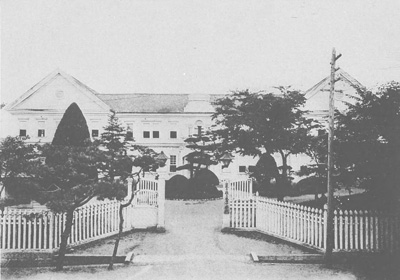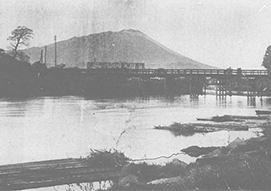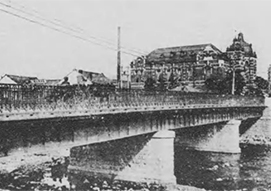Column <Tohoku>
3 The youth of Takuboku and Kenji - Morioka Middle School
Morioka Middle School (present day Morioka Daiichi High School) was established as the first middle school in Iwate-ken (Iwate Prefecture) and produced a number of talented individuals. Particularly famous among these are Ishikawa Takuboku (1886-1912) and Miyazawa Kenji (1896-1933). Takuboku was 11 years Kenji's senior.
Let me lean on the railings
Of Morioka Middle School
Just once more
-Ichiaku no Suna by Takuboku
The school building with its balconies which Takuboku wrote about in later years, was painted a beautiful white, leading to it being called "a white palace". In 1885, the school was located in where the head office of the Bank of Iwate stands today.
Takuboku
Takuboku enrolled in the school at the age of 13 in 1898. His classmates included a number of boys who would be active in political and business as well as literary circles including Nomura Kodo, a novelist known for the historical novel Zenigata Heiji Torimonohikae as well as a music critic, among the first year students; Kindaichi Kyosuke, the Japanese language linguist who looked after Takuboku throughout his life, among the 2nd year students; and Yonai Mitsumasa, who served as the 37th Prime Minister, and was a naval admiral during the end of the Second World War, among the 4th year students.
Takuboku was called a child prodigy in Shibutami-mura (Shibutani Village) and enrolled as 10th out of 128 students in academic performance, but he soon came to be devoted to literature and neglected his academic performance. His time at the school was eventful, including starting the Union Club in order to study English, participating in strikes related to lack of instructors and internal issues, and in the end, being expelled from school just before graduation for cheating (1902).
In addition, he also met Horiai Setsuko, who would later become his wife, during his middle school years. Setsuko attended Private Morioka Girls' School.
I escaped from the classroom window
And went alone
To lie in the ruins of that castle
Lying in the grass of the ruins of Kozukata Castle
My 15-year-old heart
Felt as if it was being drawn up into the sky
- Idem
Kenji
Kenji enrolled in the school in 1909. He was 12 years old. He began working on poem drafts from Spring of the same year. The next year, Takuboku's Ichiaku no Suna was published, and it is thought that Kenji's habit of writing poems in 3 lines and 4 lines may have been influenced by Takuboku.
I was taken out to buy a school badge and went out into the warm wind
- Poem Draft [B] April 1909 by Kenji
Kenji would also lie in the castle ruins and write poems, like Takuboku. The ruins of Morioka Castle remain from when the castle was demolished in 1874; however between the time when Takuboku graduated and Kenji enrolled, in 1906, the ruins had become Iwate Park.
Lying in the grass in the ruins of the castle
My heart was empty
And I could hear the sound of a saw mingling with the wind
- Poem Draft [B] April 1914
Many surprising episodes exist about Kenji's time in middle school, including his expulsion from the dormitories for participating in a boycott of the dormitory superintendent. In addition, after first reaching the summit in his 2nd year of middle school, Kenji climbed Mt. Iwate multiple times, and collected samples of plants and minerals. It could be inferred that the restaurant in the mountains, the animals that taught how to play the cello, and the many minerals and jewels which played a part of the varied adventures and amazing journeys of the Galactic Railroad, as well as other ideas of Kenji's had their origins in these mountain climbs and walks in Morioka.
Sparks may erupt and scatter from the mountain
Into the pure white sky
Near the peak
of Mt. Iwate
- Poem Draft [B] July 1917
Morioka - a modern and fashionable town
Kenji continued on to the Morioka High Agriculture and Forestry School (Present-day Iwate University Department of Agriculture). However, the photo of the school building is from before Kenji enrolled and the building was different), and lived in Morioka for nearly 10 years.
The photos of Morioka in this digital exhibition are mainly from 1908 and 1915, and these are just before and just after Kenji was enrolled at Morioka Middle School. That is to say, this shows the views of Morioka which Kenji also saw during his time.
The arc lamp glitters and shines,
And winged insects gather.
The river, bank and the green of the trees,
The town fades silently into dusk.
- Iwate Koen
The building pictured across from the bridge on the Nakatsu River on the right of the photo is the head office of the Morioka Bank, constructed in 1911. This is the "bank" which appears in Kenji's poems. The building is still in operation today as the Bank of Iwate Nakanohashi Branch and has been designated a national Tangible Cultural Property. Electricity came to Morioka in 1905, and the river and bridge were lit by electrical arc lamps. This must have seemed state of the art to the youthful Kenji, who came from Hanamaki which had no electric lighting.
Koiwai Farm, located at the southern foot of Mt. Iwate, was opened in 1891 and began selling butter in 1902, developing into a modern comprehensive farm. The farm was very enlightened, featuring an annex elementary school and day care for the children of the employees. After visiting for the first time after climbing Mt. Iwate in his second year of middle school, Kenji returned many times and wrote about the farm in his poems. (The tower pictured in the right of the photo is the Sabishii Kansokudai, and the building on the left is the Honbu no Kidotta Tatemono, both of which appear in Kenji's poem Koiwai Nojo. The Honbu building is still in use today.)
A second hometown
Kenji named Iwate "IHATOV" and Morioka "Morio".
In the transparent wind in that country, IHATOV, even in summer the sky is a blue of the most profound coldness; the town of Morillo is set amongst dazzling forests, and the surrounding countryside quivers in waves of undulating vegetation
- Porano no Hiroba
While Kenji was fully enjoying his middle school years, Takuboku made his way back to Tokyo for the last time after wandering in Hokkaido, and while supporting a family of five, he was absorbed in debt, amusement and writing, and died at the age of 27 in 1912.
Approximately 20 years later, Kenji also collapsed from overwork resulting from the gap between reality and his ideals, and died at age 37 in 1933.
The second home of these two men who never achieved success while still alive, where they glorified their youth. That place was Morioka.
Almost like an illness
This is the day I feel like thinking of my hometown.
The smoke that lingers in the sky is so sad.
- Ichiaku no Suna by Takuboku
Reference
- Ishikawa Takuboku, Ichiaku no Suna, Shinonomedo, 1910 【332-22】
- Ito Keiichiro, Ningen Takuboku: through photography, Iwate Nipposha, 1996 【KG538-G11】
- Ueda Tetsu et al., Zusetsu Miyazawa Kenji, Kawade Shobo Shinsha, 1996 【KG567-G17】
- Ogawa Tatsuo, Tonari ni ita Tensai: Morioka Chugakusei Miyazawa Kenji, Kawade Shobo Shinsha, 2005 【KG567-H52】
- Komatsu Kenichi, Takuboku Kenji Kita no Tabi, Kyoto Shoin, 1997 【KG538-G21】
- Makino Tatsuo, Kenji to Morioka, Kenji to Morioka Kanko Iinkai, 2009 【KG567-J30】
- Miyazawa Seiroku et al (ed.), (Shin) Kohon Miyazawa Kenji Zenshu, Chikuma Shobo, 1995-2001 【KH361-E15】
- The Takuboku Ten: Takuboku Seitan 120 nen Kinen 4 kan Kyodo Kikaku, Takuboku Kenji Seitan Kinen Jigyo Jikko Iinkai, 2006 【KG538-H36】
- Ichiaku no Suna(Website of the Aozora Bunko)



